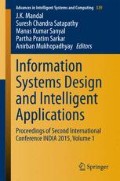Abstract
Automatic Summarization is the process of generating or extracting the important sentences from the given input document. Since there are many such systems for English language so this proposed system is mainly focused on the Hindi language. The basic idea of this summarization system is to identify the important sentences and also to extract them based on its relevance with other sentences. In case of summarization the sentences in the summarized document should be meaningful and relevant to each other, which are achieved using sentential semantic analysis. For finding the relation between each sentence and also to analyze for the importance, the Graph based approach is found to be more appropriate. Based on the frequency of words occurrence in the input document, the sentences are ranked and the ranks are used to identify the important sentences in the document. The relevance between each sentence in the document with other sentences is found using semantic similarity. There may be same information conveyed by two different sentences whose semantic similarity score is very high. Such kind of sentences has to be kept only once in the output. For which an analysis has been performed over various semantically similar sentences. Finally, the identified relevant sentences are merged using the rank and the semantic analysis of the sentences. These identified sentences are rearranged to provide a proper meaningful summarized text to avoid textual continuity in the output text. The system is found to perform well in terms of precision, recall and F-measure with various input documents.
Access this chapter
Tax calculation will be finalised at checkout
Purchases are for personal use only
References
Juneja, V., Germesin, S., Kleinbauer, T.: A learning-based sampling approach to extractive summarization. In: Proceedings of the NAACL HLT 2010 Student Research Workshop, pp. 34–39 (2010)
Gupta, V., Lehal, G.S.: A survey of text summarization extractive techniques. J. Emerg. Technol. Web Intell. 2(3), 258–268 (2010)
Gupta, V., Lehal, G.S.: Features selection and weight learning for punjabi text summarization. Int. J. Eng. Trends Technol. 2(2) (2011)
Pal, A.R., Saha, D.: An approach to automatic text summarization using WordNet. In: Advance Computing Conference (IACC), 2014 IEEE International, pp. 1169, 1173 (2014). doi:10.1109/IAdCC.2014.6779492
Devasena, C.L., Hemalatha, M.: Automatic text categorization and summarization using rule reduction. In: Advances in Engineering, Science and Management (ICAESM), 2012 International Conference on, pp. 594, 598, 30–31 Mar 2012
Kalaiselvan, M., Kathiravan, A.V.: A pioneering tool for text summarization using star map. In: Pattern Recognition, Informatics and Mobile Engineering (PRIME), 2013 International Conference on, pp. 277, 281, 21–22 Feb 2013
Moro, R., Bielikov’, M.: Personalized text summarization based on important terms identification. In: Database and Expert Systems Applications (DEXA), 2012 23rd International Workshop on, pp. 131, 135 (2012) doi:10.1109/DEXA.2012.47
Mangairkarasi, S., Gunasundari, S.: Article: semantic based text summarization using universal networking language. Int. J. Appl. Inf. Syst. 3(8), 18–23 (2012) (Published by Foundation of Computer Science, New York, USA)
Porter, M.F.: An algorithm for suffix stripping. Program 14(3) (1980)
Ramanathan, A., Rao, D.D.: A lightweight stemmer for Hindi. In: Proceedings of EACL (2003)
Alguliev, R.M., Aliguliyev, R.M.: Effective summarization method of text documents. In: Proceedings of IEEE/WIC/ACM International Conference on Web Intelligence (WI’05), pp. 1–8 (2005)
Mihalcea, R., Tarau, P.: An algorithm for language independent single and multiple document summarization. In: Proceedings of the International Joint Conference on Natural Language Processing (IJCNLP), Korea (2005)
Author information
Authors and Affiliations
Corresponding author
Editor information
Editors and Affiliations
Rights and permissions
Copyright information
© 2015 Springer India
About this paper
Cite this paper
Kumar, K.V., Yadav, D., Sharma, A. (2015). Graph Based Technique for Hindi Text Summarization. In: Mandal, J., Satapathy, S., Kumar Sanyal, M., Sarkar, P., Mukhopadhyay, A. (eds) Information Systems Design and Intelligent Applications. Advances in Intelligent Systems and Computing, vol 339. Springer, New Delhi. https://doi.org/10.1007/978-81-322-2250-7_29
Download citation
DOI: https://doi.org/10.1007/978-81-322-2250-7_29
Published:
Publisher Name: Springer, New Delhi
Print ISBN: 978-81-322-2249-1
Online ISBN: 978-81-322-2250-7
eBook Packages: EngineeringEngineering (R0)

